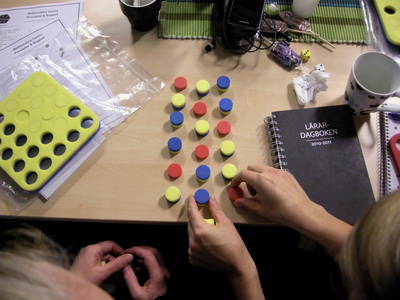
Cars In A GarageTask 2 ... Years 2 - 10SummaryCars and garages are familiar to students of all ages. In this task the challenge is to find all the ways to park the cars in the garages.
This cameo has a From The Classroom section which shows two students' journal record of their investigation and links to Cube Tube videos of three students explaining their reasoning. |
Materials
Content
|

IcebergA task is the tip of a learning iceberg. There is always more to a task than is recorded on the card. |
Possible iceberg investigations for this task are:
Offer the students simple four function calculators and invite them to carry out the multiplications in sequence ... 2x1 ... 3x2x1 ... 4x3x2x1 ... 5x4x3x2x1 ... etc. This work can be shared around the class. To the students' surprise there will come a time when the calculator runs out of screen digit space. At which number of cars does this happen? To this point primary children can be involved in this exploration which highlights the limits of the technology. Older students continue from here using a scientific calculator. What is the last multiplication string shown in decimal notation? Can students explain the new notation that suddenly appears? |
Note: This investigation has been included in Maths At Home. In this form it has fresh context and purpose and, in some cases, additional resources. Maths At Home activity plans encourage independent investigation through guided 'homework', or, for the teacher, can be an outline of a class investigation.
- Visit the Home Page for more Background.
- For this specific activity click the Learners link and on that page use Ctrl F (Cmd F on Mac) to search the task name.
Whole Class InvestigationTasks are an invitation for two students to work like a mathematician. Tasks can also be modified to become whole class investigations which model how a mathematician works. |
The whole class lesson for this task is detailed in Maths300 Lesson 128, Cars in a Garage. This lesson also extends the investigation with software. You will need at least three model cars (or substitute) per pair of students. If you have Poly Plug you can use them as a red car, a yellow car and a blue car, but you will need something else to use as a fourth and fifth car as the problem deepens.
 Swedish teachers parking their cars after a 'whole class introduction' as in Lesson 128. For more ideas and discussion about this investigation, open a new browser tab (or page) and visit Maths300 Lesson 128, Cars in a Garage, which also includes software and a class set of 5 different cut-out cars and their garages. Visit Cars in a Garage on Poly Plug & Tasks. |
Is it in Maths With Attitude?Maths With Attitude is a set of hands-on learning kits available from Years 3-10 which structure the use of tasks and whole class investigations into a week by week planner. |
The Cars in a Garage task is an integral part of:
The Cars in a Garage lesson is an integral part of:
|